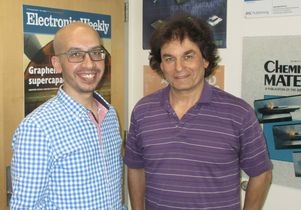Apr 16 2019
UCLA scientists and colleagues have engineered a new device that produces electricity from falling snow. This device is the first of its kind and is economical, thin, small, and flexible resembling a sheet of plastic.
 Maher El-Kady and Richard Kaner (Image credit: Stuart Wolpert/UCLA)
Maher El-Kady and Richard Kaner (Image credit: Stuart Wolpert/UCLA)
“The device can work in remote areas because it provides its own power and does not need batteries,” said senior author Richard Kaner, who holds UCLA’s Dr. Myung Ki Hong Endowed Chair in Materials Innovation. “It’s a very clever device — a weather station that can tell you how much snow is falling, the direction the snow is falling, and the direction and speed of the wind.”
The scientists have named it a snow-based triboelectric nanogenerator (snow TENG). A triboelectric nanogenerator, which produces charge through static electricity, creates energy from the exchange of electrons.
Details of the device can be found in the journal Nano Energy.
“Static electricity occurs from the interaction of one material that captures electrons and another that gives up electrons,” said Kaner, who is also a distinguished professor of chemistry and biochemistry, and of materials science and engineering, and a member of the California NanoSystems Institute at UCLA. “You separate the charges and create electricity out of essentially nothing.”
Snow is positively charged and delivers electrons. Silicone — a synthetic rubber-like material that is made up of silicon atoms and oxygen atoms, coupled with hydrogen, carbon, and other elements — is negatively charged. When falling snow touches the silicone’s surface, it generates a charge that the device captures, forming electricity.
Snow is already charged, so we thought, why not bring another material with the opposite charge and extract the charge to create electricity? While snow likes to give up electrons, the performance of the device depends on the efficiency of the other material at extracting these electrons. After testing a large number of materials including aluminum foils and Teflon, we found that silicone produces more charge than any other material.
Maher El-Kady, Study Co-Author and Assistant Researcher of Chemistry and Biochemistry, UCLA.
Snow covers about 30% of the Earth’s surface each winter, during which time solar panels frequently fail to work, El-Kady noted. The buildup of snow decreases the amount of sunlight that gets to the solar array, restricting the panels’ power output and causing them to be less effective. The new device could be incorporated into solar panels to deliver an uninterrupted power supply when it snows, he said.
The device can be used for observing winter sports, such as skiing, to more precisely evaluate and enhance the performance of an athlete when walking, running, or jumping, Kaner said. It also has the potential for recognizing the key movement patterns applied in cross-country skiing, which cannot be sensed with a smart watch.
It could facilitate a new generation of self-powered wearable devices for monitoring athletes and their performances. It can also transmit signals, specifying whether a person is moving. It can tell when a person is walking, jumping, running, or marching.
The study team used 3D printing to develop the device, which has a layer of silicone and an electrode to store the charge. The team believes the device could be created at low cost provided that there is “the ease of fabrication and the availability of silicone,” Kaner said. Silicone is extensively used in industry, in products such as electrical wire insulation, lubricants, and biomedical implants, and it currently has the potential for energy harvesting.
Co-authors include Abdelsalam Ahmed, who conducted the research while completing his doctoral studies at the University of Toronto; Islam Hassan and Ravi Selvaganapathy of Canada’s McMaster University; and James Rusling of the University of Connecticut and his research team.
Kaner’s research was sponsored by Nanotech Energy, a company spun off from his research (Kaner is chair of its scientific advisory board and El-Kady is chief technology officer); and Kaner’s Dr. Myung Ki Hong Endowed Chair in Materials Innovation.
Kaner’s laboratory has built several devices, including a membrane that isolates oil from water and cleans up the remains left by oil fracking. Fracking is a method to extract gas and oil from shale rock.
Kaner, El-Kady, and colleagues built a device in 2017 that can utilize solar energy to economically and efficiently produce and store energy, which could be used to power electronic gadgets and to produce hydrogen fuel for eco-friendly cars. This year, their research on the design of the first fire-retardant, self-extinguishing motion sensor and power generator was published, which could be implanted in clothing or shoes worn by firefighters and others who work in challenging environments.
Kaner is among the world’s most prominent and highly cited scientific scientists. He was chosen as the recipient of the American Institute of Chemists 2019 Chemical Pioneer Award, which recognizes chemists and chemical engineers who have made exceptional contributions that progress the science of chemistry or significantly impact the chemical profession.